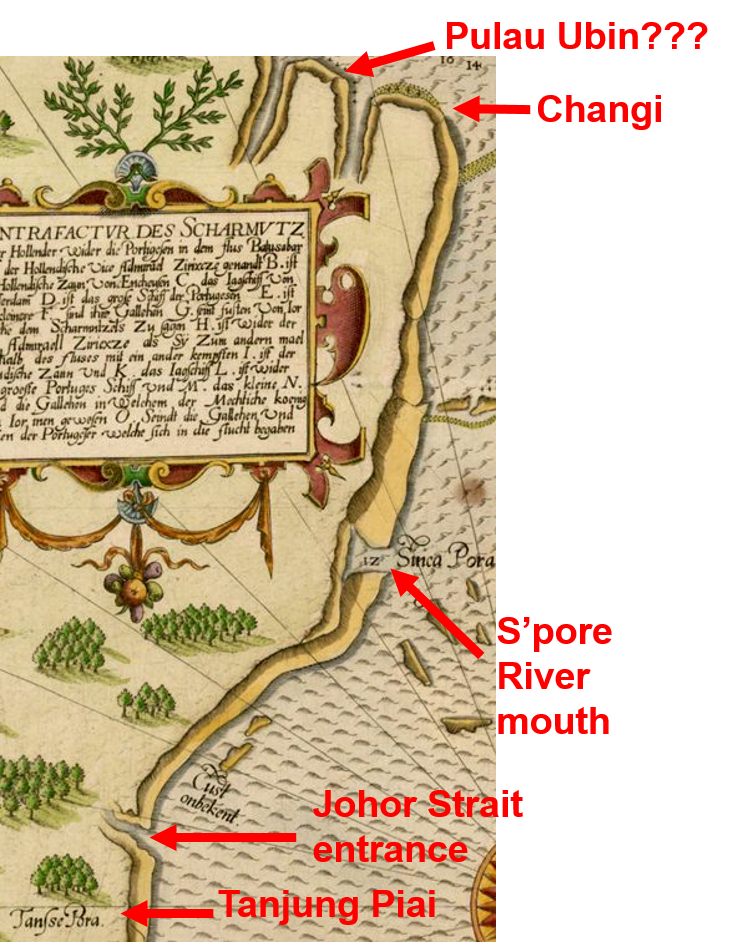Name: Contrafactur des Scharmutz els der Holander... (from Achter Theil der Orientalischen Indien, Frankfurt am Main)
Year: 1606
Publisher: Johan Theodor de Bry, Johan Israel de Bry & Johan Dieterich de Bry
 |
| Figure 1. (L) De Bry's 1607 map featuring a sea battle off the Changi coast. Source image link. (R) Google map of the similar area for reference. |
The subject of this map is a naval battle that happened on the 10th-11th of October 1603, off the coast of Changi point, Singapore. It would probably be more instructive to understand the location as the mouth of the Johor River.
This is the earliest known map that provides a close-up view of Singapore. The Google map on the right (Fig. 1 (R)) gives you an idea of the orientation and geographical location of what the de Bry map is depicting.
This is the earliest known map that provides a close-up view of Singapore. The Google map on the right (Fig. 1 (R)) gives you an idea of the orientation and geographical location of what the de Bry map is depicting.
 |
| Fig. 2. Close-up view of the de Bry map in Fig. 1(L). |
In this map, Singapore is not shown to be an island. However the general outline of the south coast of Singapore is reasonably accurate, from Tuas, in the west to Changi in the east. Fig. 2 shows an enlarged view of part of the map in Fig. 1(L) with some the geographical locations identified.
Below are some of the location names marked on the map in Fig. 1(L), and their present day names.
Oudt Ior : Old Johor. Johor Lama
Rio Batasubar : Present name: Johor River. Batasubar refers to Batu Sawar, the capital of the Johor Sultanate during that time.
Sinca Pora: Singapura. Likely the mouth of Singapore River
Tansse Pora: Tanjung Buru. Present name: Tanjung Piai, Johor, the southernmost point of the Eurasia landmass
The purpose of the map is not to portray Singapore or Johor river mouth's geography, but to detail a naval encounter between the two dominant naval powers of the day. But why were they battling off the coast of a small island thousands of miles away from their home ground?
The Portuguese and the Dutch were then fighting for supremacy for Melaka Straits and the waters off Singapore. Since their first venture to these waters at the end of the 16th century, the Dutch has been slowly eating away the Portuguese dominance of these waters. The Portuguese had been the dominant power there since conquering Melaka in 1511. The Dutch and Portuguese formed shifting alliances with the local powers of Johor (direct successor to the Melaka sultanate) and Aceh, and engaged in a series of skirmishes through the early 17th century. One major incident was the Dutch seizure of a richly laden Portuguese carrack Santa Catarina off the waters of Singapore in Febuaury 1603 with the help of the Johor sultanate.
In response, a Portuguese armada under Estêvão Teixeira de Macedo blockaded the mouth of the Johor River (where Changi and Pulayu Tekong are located) to punish the Johor sultanate then based in Batu Sawar, as well as to protect their carracks like Santa Catarina plying the Macau-Melaka trade route, lest they fall prey to the Dutch and Johoreans. A passing fleet of Dutch ships under Vice-Admiral Jacob Pietersz van Enkhuysen, responding to a request by the Johoreans to help lift the blockade, decided to engage the Portuguese fleet. The naval battle lasted from the 10th-11th of October 1603 and resulted in a Dutch victory.
For a much more detailed analysis of the origin and ramification, and blow by blow account of this naval encounter, do read the excellent book by NUS historian Peter Borschberg, entitled The Singapore and Melaka Straits [1].
Les Petit Voyages is a series of books that described the various early voyages to the East Indies. The work was initiated by a German publisher based in Frankfurt am Main, Theodor de Bry (1528-1498), and was continued after his death by his descendants.
The map described in this entry is from the appendix of the eighth book of the Les Petit Voyages series. The book was published by Theodor de Bry's sons Johan Theodor and Johan Israel. There is a German edition (1606): Achter Theil der Orientalischen Indien, and a Latin edition (1607) [2]: Indiae Orientalis Pars Octava, published in 1607.
From the coastline details and the presence of depth readings on the map, I am guessing that this map was probably derived from an actual navigation chart.
[1] P. Borschberg, The Singapore and Melaka Straits: Violence, Security and Diplomacy in the 17th Century (NUS Press, Singapore, 2013) pp 79-88.
[2] A pdf file of Achter Theil der Orientalischen Indien can be download from this link.
Thanks!
ReplyDelete